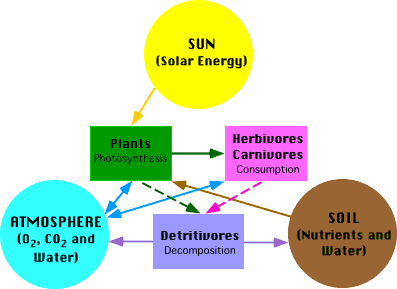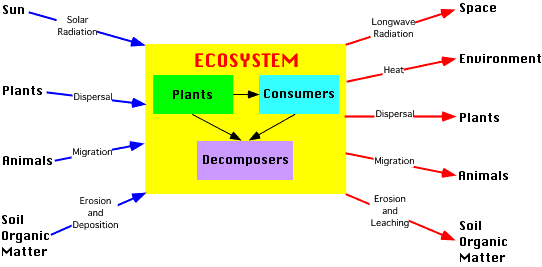Introduction
In topic 9d, an ecosystem was defined as a dynamic entity composed of a biological community and its associated abiotic environment. Often the dynamic interactions that occur within an ecosystem are numerous and complex. Ecosystems are also always undergoing alterations to their biotic and abiotic components. Some of these alterations begin first with a change in the state of one component of the ecosystem which then cascades and sometimes amplifies into other components because of relationships.
In recent years, the impact of humans has caused a number of dramatic changes to a variety of ecosystems found on the Earth. Humans use and modify natural ecosystems through agriculture, forestry, recreation, urbanization, and industry. The most obvious impact of humans on ecosystems is the loss of biodiversity. The number of extinctions caused by human domination of ecosystems has been steadily increasing since the start of the Industrial Revolution. The frequency of species extinctions is correlated to the size of human population on the Earth which is directly related to resource consumption, land-use change, and environmental degradation. Other human impacts to ecosystems include species invasions to new habitats, changes to the abundance and dominance of species in communities, modification of biogeochemical cycles, modification of hydrologic cycling, pollution, and climatic change.
Major Components of Ecosystems
Ecosystems are composed of a variety of abiotic and biotic components that function in an interrelated fashion. Some of the more important components are: soil, atmosphere, radiation from the Sun, water, and living organisms.
Soils are much more complex than simple sediments. They contain a mixture of weathered rock fragments, highly altered soil mineral particles, organic matter, and living organisms. Soils provide nutrients, water, a home, and a structural growing medium for organisms. The vegetation found growing on top of a soil is closely linked to this component of an ecosystem through nutrient cycling.
The atmosphere provides organisms found within ecosystems with carbon dioxide for photosynthesis and oxygen for respiration. The processes of evaporation, transpiration, and precipitation cycle water between the atmosphere and the Earth's surface.
Solar radiation is used in ecosystems to heat the atmosphere and to evaporate and transpire water into the atmosphere. Sunlight is also necessary for photosynthesis. Photosynthesis provides the energy for plant growth and metabolism, and the organic food for other forms of life.
Most living tissue is composed of a very high percentage of water, up to and even exceeding 90%. The protoplasm of a very few cells can survive if their water content drops below 10%, and most are killed if it is less than 30-50%. Water is the medium by which mineral nutrients enter and are translocated in plants. It is also necessary for the maintenance of leaf turgidity and is required for photosynthetic chemical reactions. Plants and animals receive their water from the Earth's surface and soil. The original source of this water is precipitation from the atmosphere.
Ecosystems are composed of a variety of living organisms that can be classified as producers, consumers, or decomposers. Producers or autotrophs, are organisms that can manufacture the organic compounds they use as sources of energy and nutrients. Most producers are green plants that can manufacture their food through the process of photosynthesis. Consumers or heterotrophs get their energy and nutrients by feeding directly or indirectly on producers. We can distinguish two main types of consumers. Herbivores are consumers that eat plants for their energy and nutrients. Organisms that feed on herbivores are called carnivores. Carnivores can also consume other carnivores. Plants and animals supply organic matter to the soil system through shed tissues and death. Consumer organisms that feed on this organic matter, or detritus, are known as detritivores or decomposers. The organic matter that is consumed by the detritivores is eventually converted back into inorganic nutrients in the soil. These nutrients can then be used by plants for the production of organic compounds.
The following graphical model describes the major ecosystem components and their interrelationships (Figure 9j-1).

Figure 9j-1: Relationships within an ecosystem.
Energy and Matter Flow in Ecosystems
Many of the most important relationships between living organisms and the environment are controlled ultimately by the amount of available incoming energy received at the Earth's surface from the Sun. It is this energy which helps to drive biotic systems. The Sun's energy allows plants to convert inorganic chemicals into organic compounds.
Only a very small proportion of the sunlight received at the Earth's surface is transformed into biochemical form. Several studies have been carried out to determine this amount. A study of an Illinois cornfield reported that 1.6% of the available solar radiation was photosythetically utilized by the corn. Other data suggests that even the most efficient ecosystems seldom incorporate more than 3% of the available solar insolation. Most ecosystems fix less than 1% of the sunlight available for photosynthesis.
Living organisms can use energy in basically two forms: radiant or fixed. Radiant energy exists in the form of electromagnetic energy, such as light. Fixed energy is the potential chemical energy found in organic substances. This energy can be released through respiration. Organisms that can take energy from inorganic sources and fix it into energy rich organic molecules are called autotrophs. If this energy comes from light then these organisms are called photosynthetic autotrophs. In most ecosystems plants are the dominant photosynthetic autotroph.
Organisms that require fixed energy found in organic molecules for their survival are called heterotrophs. Heterotrophs who obtain their energy from living organisms are called consumers. Consumers can be of two basic types: Consumer and decomposers. Consumers that consume plants are know as herbivores. Carnivores are consumers who eat herbivores or other carnivores. Decomposers or detritivores are heterotrophs that obtain their energy either from dead organisms or from organic compounds dispersed in the environment.
Once fixed by plants, organic energy
can move within the ecosystem through the consumption
of living or dead organic matter. Upon decomposition
the chemicals that were once organized into organic
compounds are returned to their inorganic form and
can be taken up by plants once again. Organic energy
can also move from one ecosystem to another by a
variety of processes. These processes include: animal
migration, animal harvesting, plant harvesting,
plant dispersal of seeds, leaching,
and erosion. The following diagram models
the various inputs and outputs of energy and matter
in a typical ecosystem (Figure 9j-2).

Figure 9j-2: Inputs and outputs of energy and matter in a typical ecosystem.